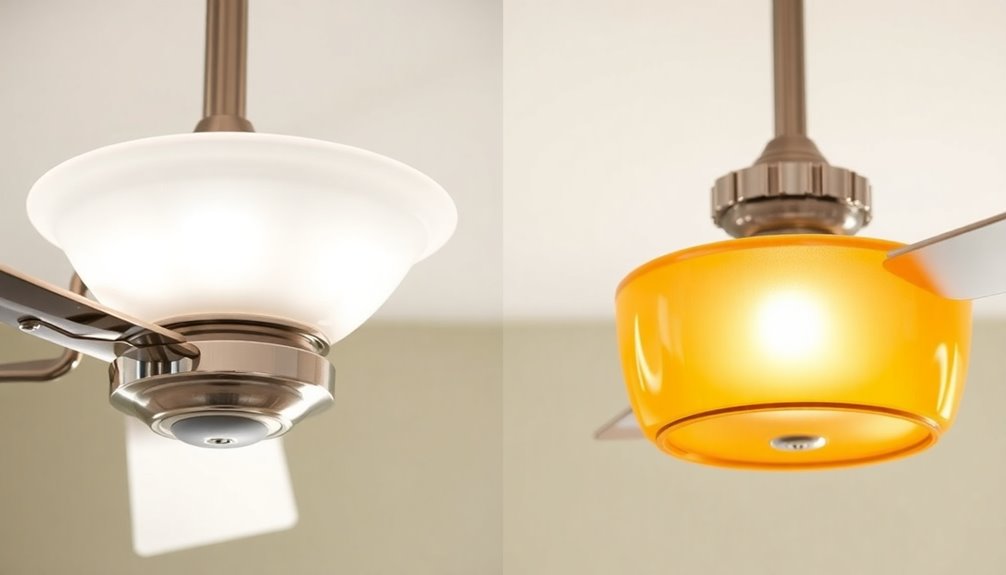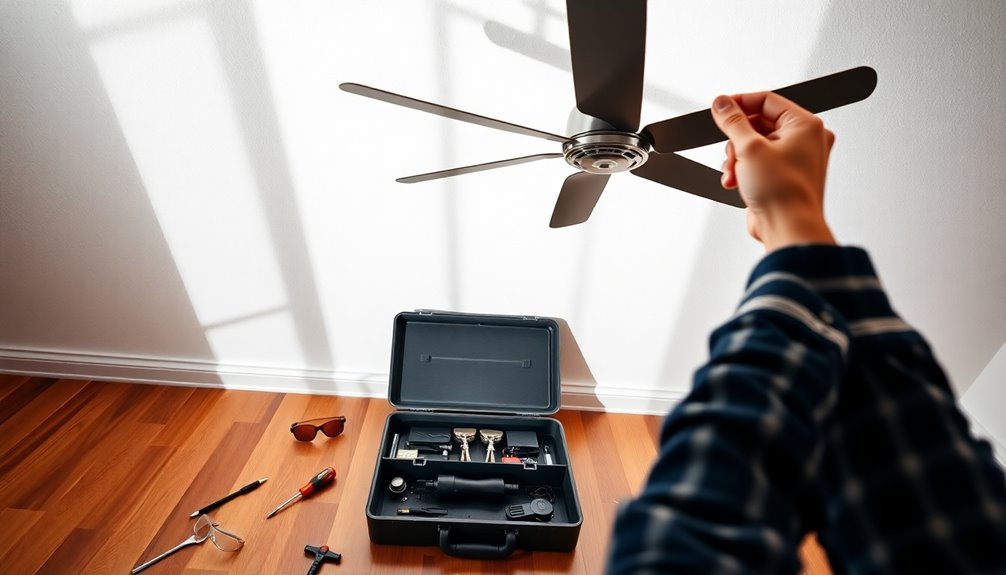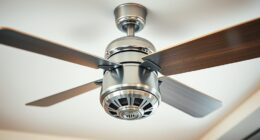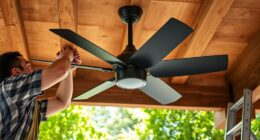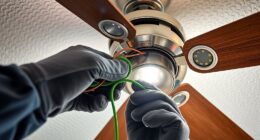Installing a ceiling fan typically sets you back between $144 and $353. If you've got existing wiring, you might pay as little as $100, but new wiring can skyrocket costs to around $2,000. Labor rates vary, often ranging from $50 to $200 an hour, depending on your location and the complexity of the job. Features like remote controls or built-in lighting can also hike the final bill. If you want to keep your budget in check, exploring cost-saving strategies is smart. There's more you might find useful when considering your ceiling fan installation plans!
Key Takeaways
- Average installation costs for ceiling fans range from $144 to $353, with typical expenses around $248.
- Utilizing existing wiring can reduce installation costs to between $100 and $300.
- New wiring installation can significantly raise expenses, potentially reaching up to $2,000.
- Additional features, like remote controls or separate switches, can add $100 to $200 to the total bill.
- Hiring a handyperson for simple tasks may save you $50 to $200 compared to professional contractors.
Ceiling Fan Installation Costs
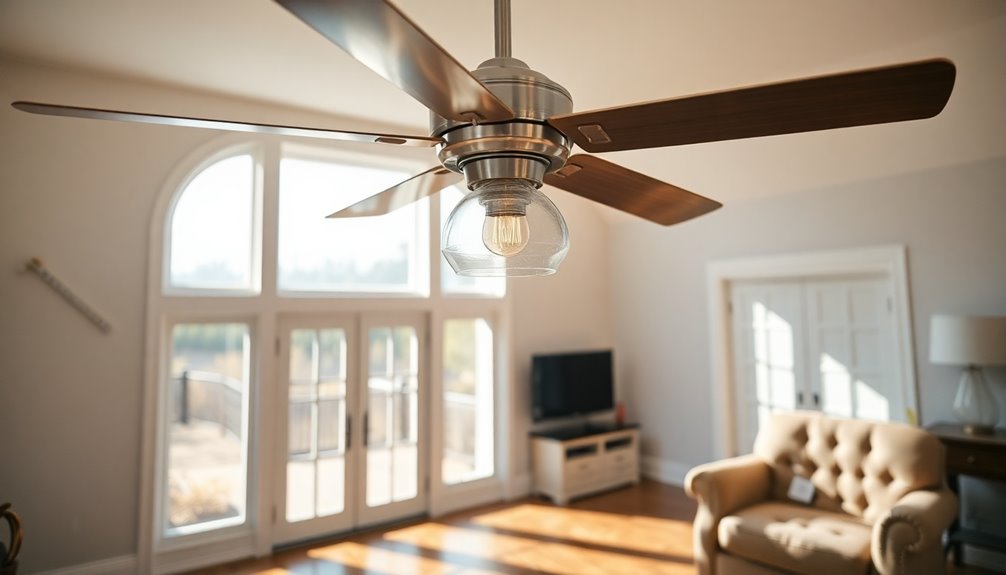
When you're looking to install a ceiling fan, you might want to get a handle on the costs involved. The average cost to install a ceiling fan ranges from $144 to $353, with a typical installation cost around $248.
If you're using existing wiring, you could lower costs to between $100 and $300. However, if new wiring is required, you might face installation costs soaring up to $2,000.
Labor costs for professional installation typically range from $50 to $200 per hour, depending on your location and the job's complexity. For basic setups, installation time is usually 1-2 hours, but if you have a more complex installation, expect it to take 3-4 hours.
Keep in mind that if you're considering additional features like built-in lights or remote controls, these can add $100 to $300 each to your overall installation costs. Additionally, many consumers are now interested in energy-efficient appliances, which can further enhance long-term savings on electricity bills.
Factors Affecting Installation Prices
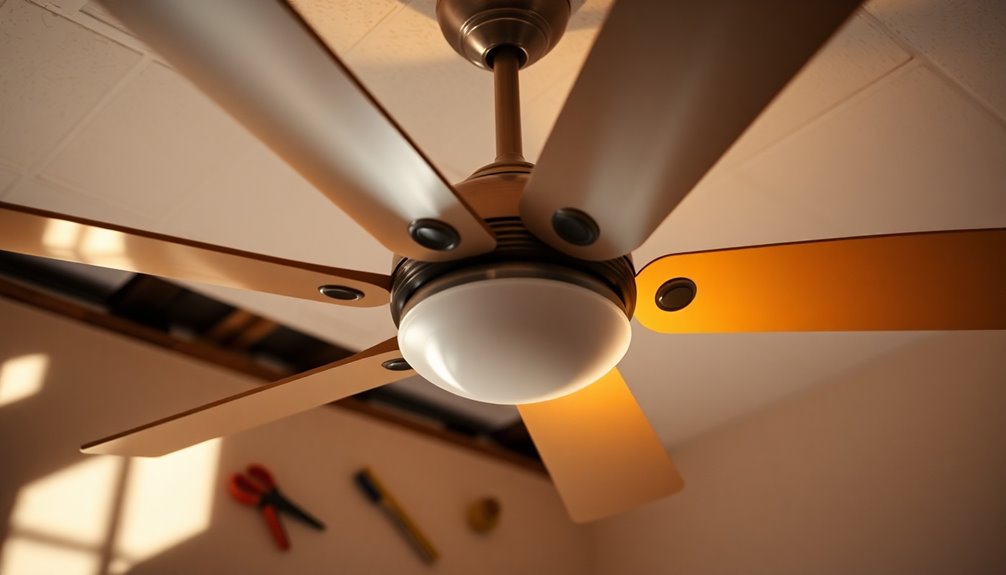
When you're considering the cost of installing a ceiling fan, remember that labor rates can vary widely based on where you live and the complexity of the job.
Wiring requirements also play a vital role; using existing wiring can save you money, while new wiring can add significant costs.
Be sure to factor in these elements as you estimate your total installation expenses.
Labor Rate Variations
Labor rates for ceiling fan installation can vary widely, influenced by several key factors. Typically, you'll find labor costs ranging from $50 to $200 per hour, depending on the experience of the installer. Geographic location plays a significant role here; urban areas usually charge more than rural regions due to demand and cost of living.
The complexity of your installation also affects the total cost. If you need a professional electrician for complicated setups or new wiring, expect higher fees. Extensive installations can push costs up to $2,000, especially if they require specialized skills or equipment.
Additionally, the presence of existing wiring or the height of your ceiling may complicate the job further, adding to labor time.
If you're planning to install multiple fans, you might save on overall labor expenses. Scheduling those installations simultaneously can minimize travel fees and increase efficiency for the contractor, ultimately lowering your total cost.
Wiring Requirements Impact
Understanding wiring requirements is essential for estimating the cost of your ceiling fan installation. If you have existing wiring that's compatible, your installation costs can range from $100 to $300.
However, if new wiring is necessary, you could be looking at costs up to $2,000. The complexity of the wiring plays a considerable role too, especially if you need separate switches for the fan and light controls; this can add an additional $100 to $200 to your overall installation price.
For outdoor fans, you'll need to take into account wet-rated electrical components, which can greatly impact total costs. If your ceiling box isn't designed to support a fan, you'll need to install a fan-rated junction box and brace, potentially adding another $50 to $100 to your expenses.
Labor costs for wiring installation can also vary based on your location, typically ranging from $50 to $200 per hour. This means that the more complex your wiring setup, the higher your labor costs will be, ultimately affecting your total installation price.
Types of Ceiling Fans
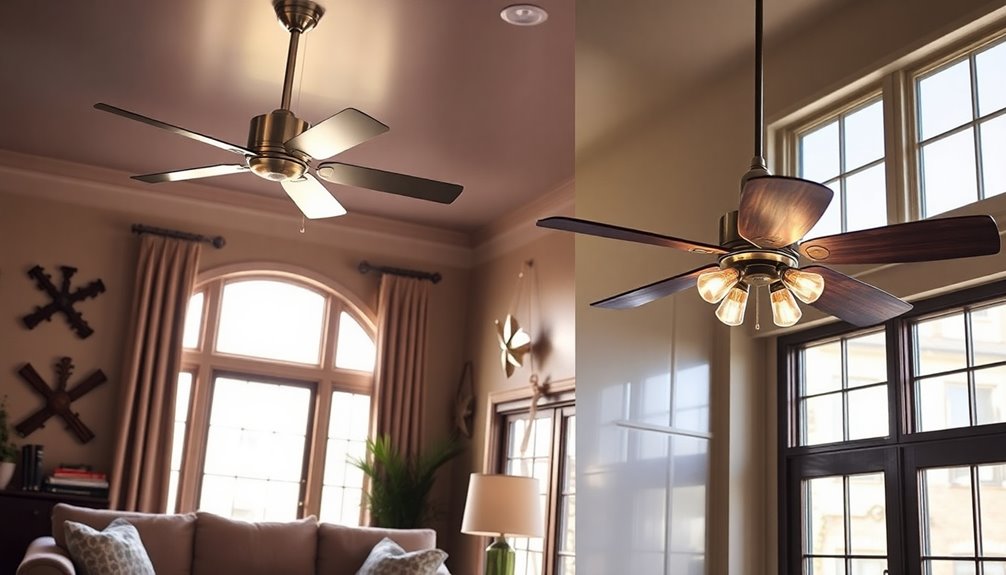
Ceiling fans come in various types, each designed to meet specific needs and aesthetics in your home.
Standard ceiling fans are the most common choice for residential spaces, with installation costs typically ranging from $50 to $300. If you're dealing with low ceilings, low-profile ceiling fans are perfect and have similar installation costs. These fans are often designed to maximize airflow efficiency, ensuring comfort in smaller spaces. Regular maintenance of these fans can help prevent mechanical failure and prolong their lifespan. Additionally, choosing energy-efficient technology can significantly reduce energy bills over time. Regular servicing of these fans can also help maintain optimal performance and prevent unnecessary wear.
For homes with high ceilings, hanging propeller fans are a great option, but expect higher installation costs averaging between $150 and $550.
If you're looking for versatility, directional ceiling fans allow for adjustable airflow, with installation costs varying from $150 to $800, depending on complexity.
On the other hand, rotational ceiling fans are known for their intricate designs and features, leading to installation costs between $200 and $1,500.
Choosing the right type of ceiling fan isn't just about aesthetics; it also involves considering the installation costs associated with each option. Additionally, selecting energy-efficient fans can contribute to lower water usage and help reduce overall utility bills in your home.
Whether you're installing a new fan or replacing an old one, understanding these types of ceiling fans will help you make an informed decision that fits your budget and space requirements.
DIY vs. Professional Installation
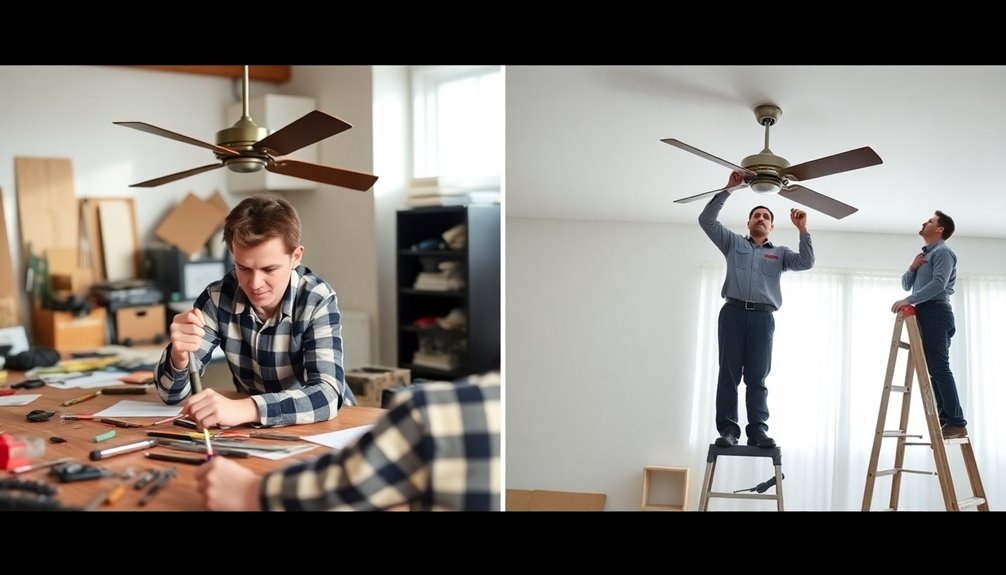
When it comes to installing a ceiling fan, you might wonder whether to tackle the job yourself or hire a professional. DIY ceiling fan installation can save you between $50 and $200 on labor costs, but it requires solid knowledge of electrical work and compatible wiring. If your setup is straightforward, you might manage it, but for more complex jobs, like adding new wiring or switches, it's best to call in an expert.
Here's a quick comparison of DIY vs. professional installation:
| Aspect | DIY Installation | Professional Installation |
|---|---|---|
| Cost of Labor | $0 – $200 savings | $100 – $300 |
| Average Installation Time | 2+ hours | 1-2 hours |
| Safety Compliance | Risk of code violations | Guarantees safety codes met |
While you save on installation costs with a DIY approach, take into account potential hazards. Improper installation could lead to safety issues. If you're unsure about the wiring or switches, it's wise to hire an electrician to install your ceiling fan. Make the right choice based on your skill level and the fan's requirements!
Cost-Saving Strategies
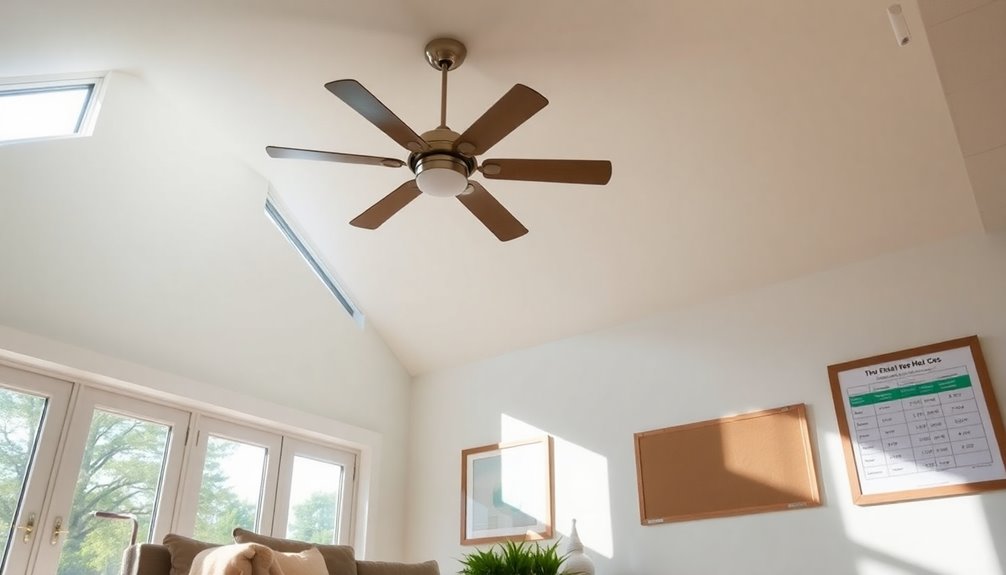
Finding ways to save money on ceiling fan installation can make a significant difference in your overall budget. One effective cost-saving strategy is to install your ceiling fan where existing wiring is available, which can reduce installation costs to as low as $100 to $300.
Moreover, choosing a fan that's compatible with your current switch can save you another $100 to $200.
Timing your purchase can also yield savings. Look for discounts during off-peak seasons, which can help you save 10-30% on both the retail price and installation.
In addition, opting for Energy Star-rated ceiling fans not only offers potential rebates but also guarantees long-term savings on your utility bills.
When it comes to installation, consider hiring a handyperson for simple ceiling fan replacements instead of a licensed electrician. This choice could save you $50 to $200.
Weigh the benefits of DIY vs. hiring a professional; if you have the skills, doing it yourself can additionally reduce costs. Furthermore, investing in energy-efficient models can lead to long-term savings on your utility bills, similar to the benefits offered by Energy Star-rated appliances.
Additional Costs to Consider

When you're budgeting for your ceiling fan installation, don't forget to factor in additional costs.
If your project requires new wiring, you could see your expenses soar by up to $2,000.
Plus, adding features like remote controls or built-in lighting can really impact your final bill, so be sure to account for those extras.
Wiring Requirements
Installing a ceiling fan often involves more than just the fan itself; you'll need to evaluate the wiring requirements, which can add significant costs.
If your existing wiring isn't compatible, you could face additional expenses of up to $2,000 for new wiring installation to comply with electrical codes. Even if your wiring is adequate, installing your ceiling fan with new wiring can still run between $500 to $1,500, depending on complexity.
You should also check if your ceiling box is rated for fan support. If it isn't, you'll need to purchase a fan-rated junction box and possibly a fan brace, which can further increase costs.
If you plan on having a separate switch for lights or multiple controls, you can expect to pay an extra $100 to $200. Additionally, if you're installing an outdoor ceiling fan, specialized wiring will be required to guarantee it's wet-rated, adding more to your overall budget.
Additional Features Costs
Once you've tackled the wiring requirements for your ceiling fan, it's time to contemplate additional features that can impact your overall costs.
The ceiling fan installation cost can rise considerably with the addition of built-in lighting. Expect to pay an extra $100 to $300 for a light fixture that enhances both illumination and air circulation.
If you value convenience, a remote control option will set you back another $150 to $300.
For more versatile control, installing separate switches for lights and fans can add between $100 and $200.
If your ceiling fan needs a downrod due to higher ceilings, that'll cost you $10 to $75, depending on the materials and length required.
If you're considering outdoor ceiling fans, be prepared for specialty installations, which can range from $250 to over $4,000, as they need to be wet-rated for outdoor use.
These additional features costs can really add up, so weigh your options carefully to guarantee you get the best value while enhancing your space.
Frequently Asked Questions
How Much Should It Cost to Have Someone Install a Ceiling Fan?
When hiring someone to install a ceiling fan, you should expect to pay between $100 and $353, depending on wiring and features.
If you already have wiring in place, costs could be lower.
For added features like lighting or remote controls, factor in an extra $100 to $300 each.
Always ask for detailed estimates and check the electrician's credentials to avoid surprises and guarantee a smooth installation process.
Do You Need an Electrician to Install a New Ceiling Fan?
Do you really want to risk a DIY ceiling fan installation? Hiring an electrician is often the safest choice, especially if you need new wiring.
They guarantee everything's up to code and properly supported. While you might save money by doing it yourself, a licensed pro can handle potential hazards you mightn't notice.
Plus, they'll finish the job in just a few hours, giving you peace of mind and a cool room.
Can a Handyman Install a Ceiling Fan?
Yes, a handyman can install a ceiling fan, especially if there's existing wiring.
They typically handle basic installations, taking about 1 to 2 hours.
Just make certain your handyman has experience with electrical work and understands the specific requirements for ceiling fans.
If your installation's complex or requires new wiring, it's safer to hire a licensed electrician to guarantee everything's up to code.
Always prioritize safety when dealing with electrical installations!
Are Ceiling Fans Expensive to Run?
Imagine a gentle breeze whispering through your home on a hot summer day—ceiling fans are your cool companions.
They're not expensive to run at all! With average costs around $0.01 to $0.02 per hour, you can keep your space comfortable without breaking the bank.
Plus, they help lower your air conditioning costs by creating a wind-chill effect.
Conclusion
In the end, investing in a ceiling fan can transform your space and comfort without breaking the bank. With installation costs varying based on factors like fan type and labor, it's crucial to weigh your options. Whether you choose to go the DIY route or hire a pro, the right fan can create a revitalizing breeze that makes you feel right at home. So, why wait? Your ideal sanctuary is just a fan away!

